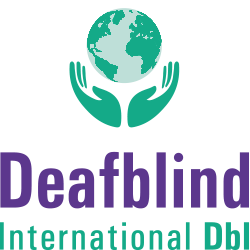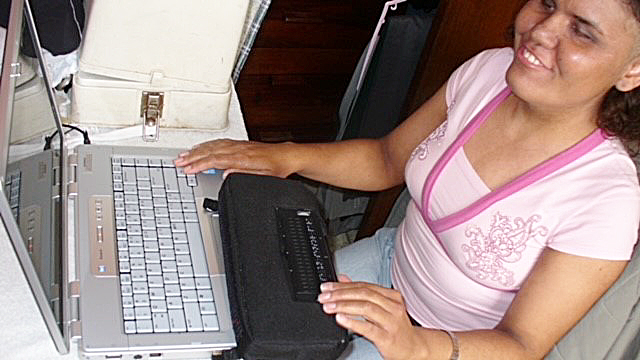Ene Eneida Guadalupe Rendón Nieblas is person from Mexico.
He has been a member and ambassador of the International Chamber of Speakers since August 2020. He works in the library of the Virtual University System of the University of Guadalajara as responsible for specialized services for people with visual disabilities.
She co-authored the article “Building paths towards accessibility for people with sensory and physical disabilities”, published in April 2019 in the magazine of the Latin American Sociological Association (ALAS).
She is a member of the group “Ambassadors for digital accessibility”, where she collaborates with projects aimed at giving people with disabilities access to information and technology.
She is an individual associate member of the Latin American Federation of Deafblind (FLASC), since 2007.
What technology do you use in your day to day? Computer? Smartphone? Tablet? Tell us what you use.
Computer, cell phone and iPad.
What needs do you have to be able to use these devices?
That the environment is not noisy when I use them with voice; that the contents and buttons are accessible so that they can be well captured by screen readers; that the applications are accessible; that they are not asked to respond with captchas in distorted images or audios.
How do you manage to use them despite your visual and hearing difficulties. What adaptations do you usually use to be able to use them? Screen readers? Braille lines? Magnifiers? Etc. Tell us how you use the devices
I use them with a screen reader. The one I use with the computer and called NVDA, can be used with speech and braille display, I have a small one although I hardly use it anymore because the points are wearing out. When I need to hear better and there is a lot of noise, or when I am in the office and I cannot use my voice so as not to interrupt colleagues, I use headphones that I connect via Bluetooth with the devices and my cochlear implant, so I can choose between just listening to my device or being able to also listen to the environment. When I only select to listen to the device it is because the noise is quite loud like at parties. With my cell phone and iPad I don’t use the braille display because the one I have cannot connect to these devices.
What other devices do you also use everyday? Bluetooth watches and bracelets? Alarm clocks? Tell us about any technology you use in your day by day, what it is, what you use it for, how you use it and how it helps you.
Braille clock, to see the time.
Cochlear implant to listen only in the left ear.
Artone3Max. It is a device that works as hearing aids and that allows the cochlear implant to be connected via Bluetooth with devices such as a computer, cell phone and others, since due to the characteristics of my implant I cannot use almost any other type of headband hearing aids or pellet.
Alarm clock that vibrates, although I don’t use it very often right now, I use it more when I’m alone to feel safe to wake up since when I sleep I do it without an implant, that is, with total deafblindness and only through vibration can I feel a stimulus .
Walking stick. It is the traditional white cane with red stripes. I use it to feel more secure and at the same time give my companion peace of mind. Also when I move alone in large spaces like my workplace.
Scanner. I only use it at work, to read printed texts on the computer. It is a work tool since there we scan printed books to be digitized.
Braille printer. I also only use it at work, to print texts in braille.
Do you like reading? How do you read: in braille, in voice with your hearing aids, on the screen? What difficulties do you encounter and how do you solve them?
I do like reading. I read in braille, although in reality there is very little material and as I already mentioned, the braille display that I have requires maintenance and it is no longer so easy for me to read in it. This is why I read a lot with voice with the synthetic voice of screen readers and my cochlear implant.
One of the difficulties I find myself with is that there are books that are not accessible. To solve this, I try to support myself with OCR (Optical Character Recognition), using pages like Robo Braille, which are dedicated to converting texts to accessible formats, for example, PDF to Word. When nothing of what I have mentioned helps me, I go to the help of a person to read me aloud.
What Apps and Smartphone utilities help you the most in your communication and access to information? Social networks? WhatsApp? Utilities to manage aspects of your autonomy and your day to day: banks, health, recognition of objects and characters ?, etc. Tell us the ones you use the most and the help they give you.
WhatsApp, email, text messages and phone to keep me in touch. The bank’s application to keep track and monitor that there are no unknown payments on the cards, I still can’t do many things like transfers. The Google Maps, to know where I am located and to know where a place is. The Google search engine, to search and access information, know the weather, etc. The Internet browser, to access pages or any type of information. Programs that recognize objects, images or colors, to know what color clothes are, recognize images that are sent to me by WhatsApp or other networks, in short, have a little contact with the visual. The voice recorder, to record notes, record my music lessons and send them to my teacher to listen to the progress. The camera, although on my current cell phone, is not so accessible, but it has solved some things for me, for example, if I want to know what a piece of paper says, I can send a photo via WhatsApp to ask when the program that recognizes characters is not available or not You can interpret it because it is handwritten or with poor quality; also to send the photo of the water meter every month. Google Drive, to share and receive information.
What do you miss when it comes to using technology? If companies and entities made more investment and allocated more resources to facilitate technology for deafblind people, what do you think would be more interesting for deafblind people if it was researched and developed?
That the applications of the different stores to make purchases online were completely accessible. An application that describes videos through texts. Make braille displays cheaper and easier to get.
What programs and technological devices do you think are not accessible to deafblind people?
There are many programs such as games and purchases that are not accessible. There are screen reader programs like TalkBack that do not have the braille functions for use with braille displays.
Tell us what you want about your experience with technology and what it means for you as a person with deafblindness to be able to use accessible technology: what solutions and for what aspects of your life and your day to day do you see that the use of these technologies helps you : For your communication? How does it help aspects of your daily life? To access the information?
Technology helps me in many ways: I can communicate with people from anywhere in the world, work, make payments such as electricity and the internet, do research on things that interest me, find out what the medicines I take are for, order a taxi , find out about the news, have both synchronous and asynchronous distance classes, read books, browse internet pages, network, manage new projects, help other people, in short, feel more independent.

